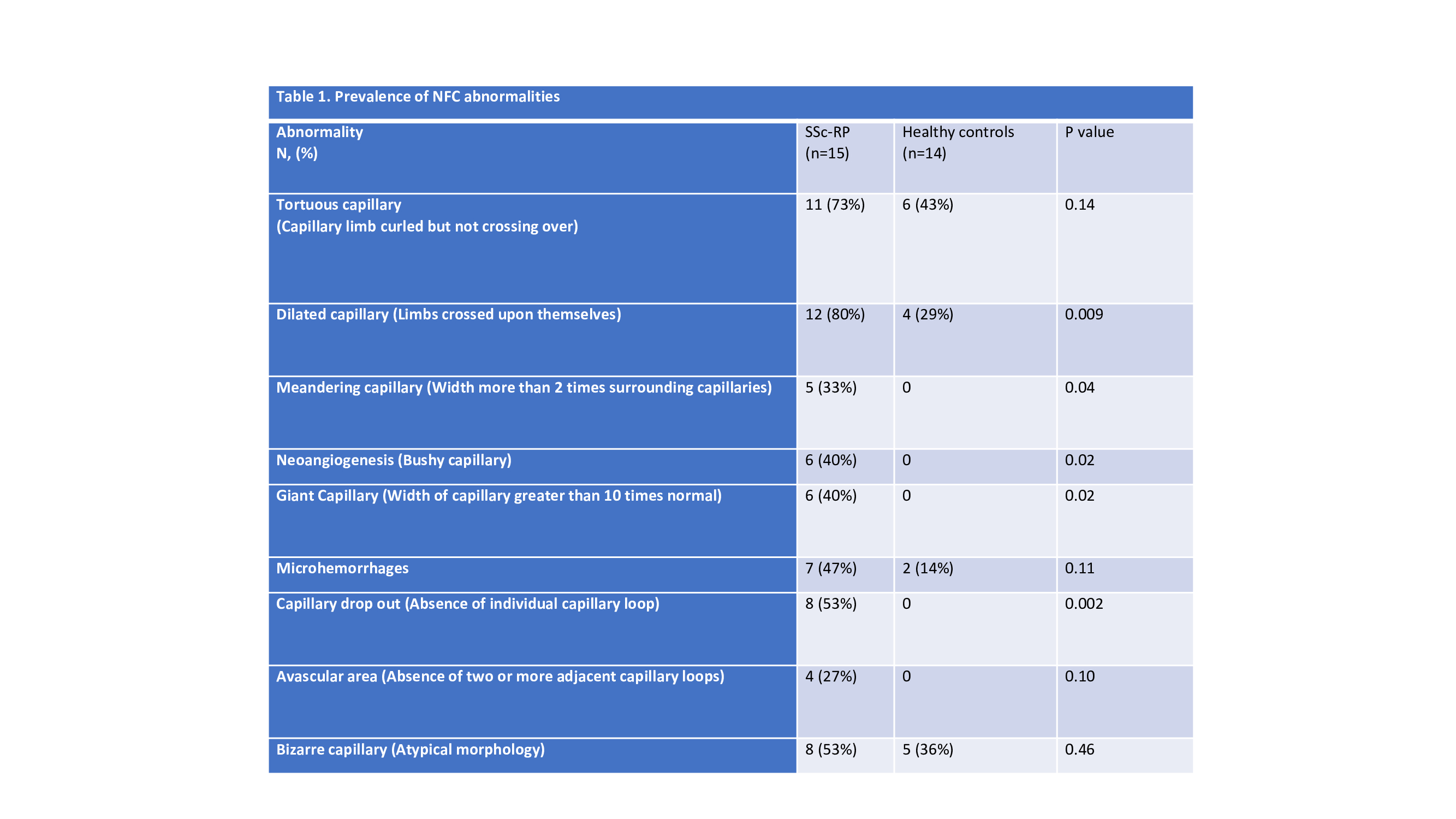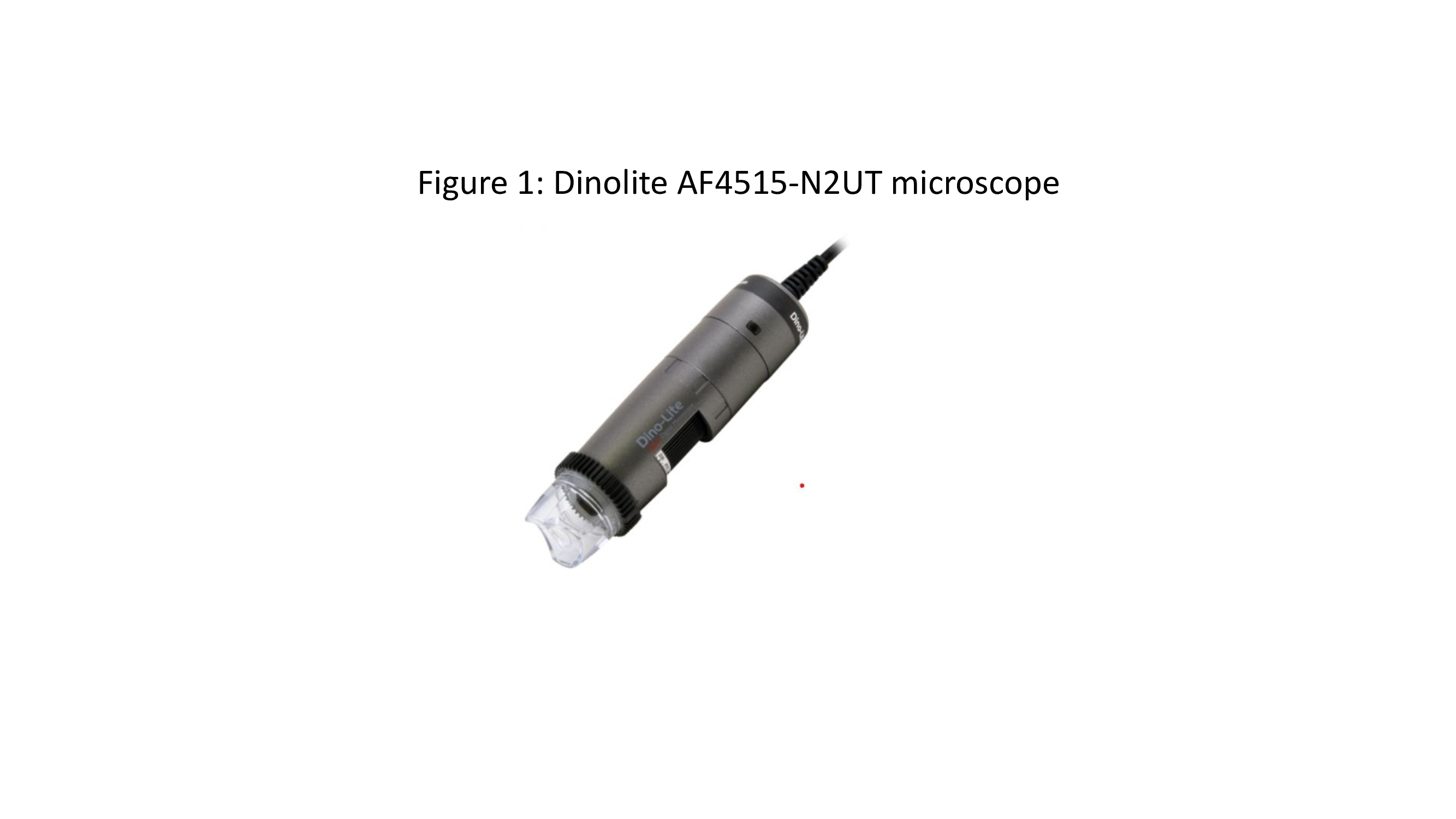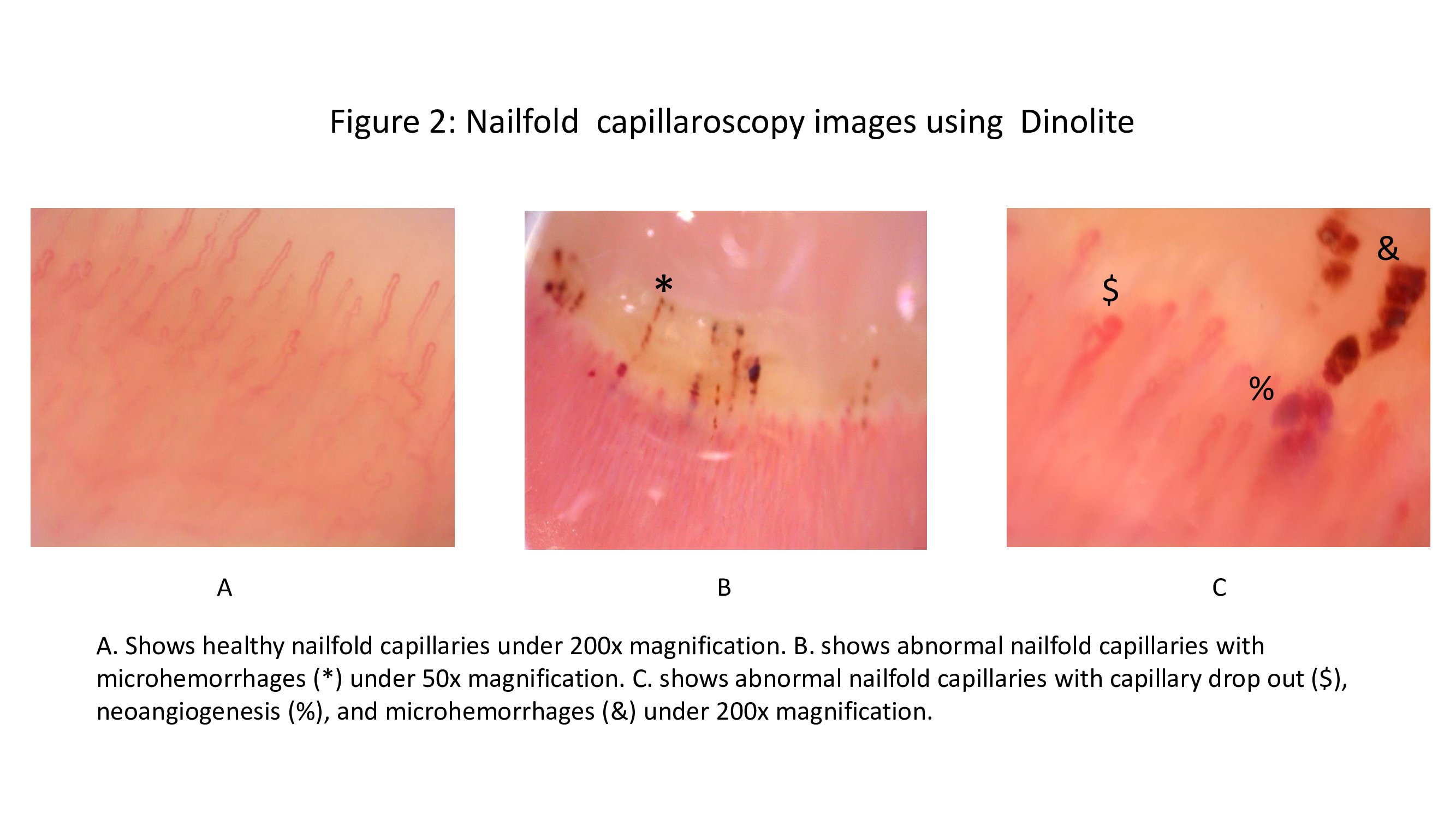Back
Poster Session C
Fibrosing rheumatic diseases (scleroderma, MCTD, IgG4-related disease, scleroderma mimics)
Session: (1518–1542) Systemic Sclerosis and Related Disorders – Clinical Poster II
1529: Clinical Nailfold Capillaroscopy Using Dinolite Microscope in Patients with Systemic Sclerosis
Sunday, November 13, 2022
1:00 PM – 3:00 PM Eastern Time
Location: Virtual Poster Hall
- KM
Krishnasai Abhishek Madathanapalli, MBBS
University of Connecticut School of Medicine
Hartford, CT, United States
Abstract Poster Presenter(s)
Krishnasai Abhishek Madathanapalli1, Alyssa Williams2, Baran Ilayda Gunes2, Francis Perry Wilson3, John Pauling4, Robyn Domsic5, Lan Yu6 and Monique Hinchcliff7, 1University of Connecticut School of Medicine, Hartford, CT, 2Yale University, New Haven, CT, 3Yale school of medicine, New Haven, CT, 4North Bristol NHS Trust, Bristol, United Kingdom, 5University of Pittsburgh, Pittsburgh, PA, 6University of Pittsburgh School of Medicine, Pittsburgh, 7Yale School of Medicine, Westport, CT
Background/Purpose: The clinical importance of nailfold capillaroscopy (NFC) has grown since its inclusion in the 2013 ACR/EULAR Classification Criteria for systemic sclerosis (SSc), yet few centers have expensive video NFC systems, and dermatoscope evaluations have limited sensitivity for abnormality detection. Dinolite™ (AF4515-N2UT) offers a handheld, inexpensive, and convenient method for in-clinic NFC images at 200x magnification (Fig. 1). We piloted the clinical utility of Dinolite NFC in patients with SSc.
Methods: Patients who fulfilled ACR/EULAR 2013 SSc Classification Criteria with Raynaud phenomenon (RP) symptoms (n=15) and healthy controls (HC) (n=14) were recruited to this prospective pilot study. Dinolite NFC was performed for bilateral fingers, excluding the thumb, in the clinic. Two adjacent 1mm images in the middle of the nailfold were captured and analyzed for each finger (Fig. 2). First, a blinded assessor classified NFC as "normal" or "abnormal" based on the presence or absence of the "scleroderma pattern" as previously described. Second, the prevalences of specific NFC morphological abnormalities were recorded (Table 1). Lastly, the distal capillary row was analyzed using Dinolite measurement software to calculate per linear mm, 1) Mean semi-quantitative score (0 = no changes, 1 = ≤ 33%, 2 = 34–66%, 3 = ≥ 67%) for proportion of capillary alterations/reductions consistent with scleroderma pattern, and 2) Mean capillary density. Patients completed the newly developed RP patient-reported outcome, the Assessment of Systemic Sclerosis – Associated Raynaud Phenomenon (ASRAP) questionnaire (range 20-80, with higher scores indicating worse symptoms). Descriptive statistics, Fischer exact tests, Spearman's Rho coefficient, and Wilcoxon rank-sum tests were performed using Stata, v.17.0, College Station, TX.
Results: Patients with RP and HC, respectively, were predominantly white (n=10, 67% vs. n=10, 71%) women (n=13, 87% vs. n=13, 93%) with a median (IQR) age of [59 (49-64) vs. 48 (39-57)]. Scleroderma NFC pattern was more prevalent in SSc compared to HC (87% vs. 0%, p< 0.001). Mean semi-quantitative score in SSc was 1.88 compared to 0 in HC (p< 0.001). Mean capillary density measured per linear mm was lower in SSc compared to HC (5.5 vs. 9.3, p< 0.001). Prevalence of various specific NFC abnormalities tended to be higher in SSc compared to HC (Table 1) with significantly more dilated capillaries, meandering capillaries, neoangiogenesis, giant capillaries, and capillary drop-out in SSc. Among SSc patients, mean (SD) ASRAP score was 53.2±11.9 and correlated significantly with mean semi-quantitative score (rho 0.59, p=0.02).
Conclusion: SSc patients have more NFC abnormalities and lower mean capillary densities than HC as assessed using Dinolite. More NFC abnormalities (mean semi-quantitative score) as assessed using Dinolite are present in SSc-RP who reported worse RP symptoms as assessed by the ASRAP instrument. Future work includes a larger longitudinal study with greater diversity to investigate associations between NFC abnormalities, ASRAP scores, and characteristics including disease duration and subtype, presence of digital ulcerations, medications, and laboratory parameters.



Disclosures: K. Madathanapalli, None; A. Williams, None; B. Gunes, None; F. Wilson, Amgen, Boeringher-Ingelheim, Vifor Pharma, Whoop, AstraZeneca; J. Pauling, None; R. Domsic, None; L. Yu, None; M. Hinchcliff, Kadmon.
Background/Purpose: The clinical importance of nailfold capillaroscopy (NFC) has grown since its inclusion in the 2013 ACR/EULAR Classification Criteria for systemic sclerosis (SSc), yet few centers have expensive video NFC systems, and dermatoscope evaluations have limited sensitivity for abnormality detection. Dinolite™ (AF4515-N2UT) offers a handheld, inexpensive, and convenient method for in-clinic NFC images at 200x magnification (Fig. 1). We piloted the clinical utility of Dinolite NFC in patients with SSc.
Methods: Patients who fulfilled ACR/EULAR 2013 SSc Classification Criteria with Raynaud phenomenon (RP) symptoms (n=15) and healthy controls (HC) (n=14) were recruited to this prospective pilot study. Dinolite NFC was performed for bilateral fingers, excluding the thumb, in the clinic. Two adjacent 1mm images in the middle of the nailfold were captured and analyzed for each finger (Fig. 2). First, a blinded assessor classified NFC as "normal" or "abnormal" based on the presence or absence of the "scleroderma pattern" as previously described. Second, the prevalences of specific NFC morphological abnormalities were recorded (Table 1). Lastly, the distal capillary row was analyzed using Dinolite measurement software to calculate per linear mm, 1) Mean semi-quantitative score (0 = no changes, 1 = ≤ 33%, 2 = 34–66%, 3 = ≥ 67%) for proportion of capillary alterations/reductions consistent with scleroderma pattern, and 2) Mean capillary density. Patients completed the newly developed RP patient-reported outcome, the Assessment of Systemic Sclerosis – Associated Raynaud Phenomenon (ASRAP) questionnaire (range 20-80, with higher scores indicating worse symptoms). Descriptive statistics, Fischer exact tests, Spearman's Rho coefficient, and Wilcoxon rank-sum tests were performed using Stata, v.17.0, College Station, TX.
Results: Patients with RP and HC, respectively, were predominantly white (n=10, 67% vs. n=10, 71%) women (n=13, 87% vs. n=13, 93%) with a median (IQR) age of [59 (49-64) vs. 48 (39-57)]. Scleroderma NFC pattern was more prevalent in SSc compared to HC (87% vs. 0%, p< 0.001). Mean semi-quantitative score in SSc was 1.88 compared to 0 in HC (p< 0.001). Mean capillary density measured per linear mm was lower in SSc compared to HC (5.5 vs. 9.3, p< 0.001). Prevalence of various specific NFC abnormalities tended to be higher in SSc compared to HC (Table 1) with significantly more dilated capillaries, meandering capillaries, neoangiogenesis, giant capillaries, and capillary drop-out in SSc. Among SSc patients, mean (SD) ASRAP score was 53.2±11.9 and correlated significantly with mean semi-quantitative score (rho 0.59, p=0.02).
Conclusion: SSc patients have more NFC abnormalities and lower mean capillary densities than HC as assessed using Dinolite. More NFC abnormalities (mean semi-quantitative score) as assessed using Dinolite are present in SSc-RP who reported worse RP symptoms as assessed by the ASRAP instrument. Future work includes a larger longitudinal study with greater diversity to investigate associations between NFC abnormalities, ASRAP scores, and characteristics including disease duration and subtype, presence of digital ulcerations, medications, and laboratory parameters.



Disclosures: K. Madathanapalli, None; A. Williams, None; B. Gunes, None; F. Wilson, Amgen, Boeringher-Ingelheim, Vifor Pharma, Whoop, AstraZeneca; J. Pauling, None; R. Domsic, None; L. Yu, None; M. Hinchcliff, Kadmon.

